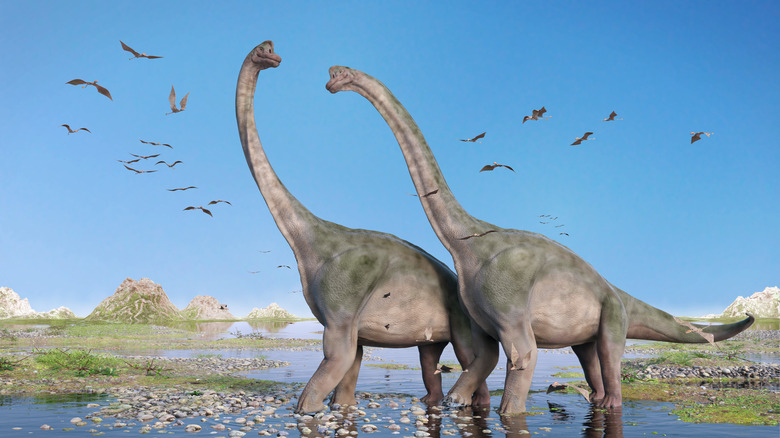Varieties Of Long-Necked Dinosaurs
Dinosaurs with long necks are part of the sauropod clade, a group of plant-eating dinosaurs. They tend to have elongated necks, thick legs and smaller heads. They used their necks to reach taller trees and plants, so they could eat the leaves – being herbivores. These long-necked dinosaurs were some of the largest dinosaurs and largest animals to ever exist. All of these sauropods still fall under the classification of reptiles
Diplodocus
Diplodocus
Diplodocus, a herbivorous dinosaur that lived 150 million years ago during the late Jurassic period, had four large, sturdy legs to support its long neck and whip-like tail. It measured around 98 feet in length and weighed around 16 tons. It was first discovered in North America in 1877.
Apatosaurus
Apatosaurus
Another herbivore, Apatosaurus, used its peg-like teeth to strip leaves from trees but not for chewing. It probably swallowed stones in order to grind food in its gizzard. Like Diplodocus, Apatosaurus could whip its tail to defend itself from meat eaters. It measured around 33 tons and was approximately 70 feet long. Apatosaurus used to be known as brontosaurus as a result of a labeling error.
Camarasaurus
Camarasaurus
The holes in Camarasaurus' vertebrae led to its name, given in 1877, which means "chambered lizard". Camarasaurus lived in North America during the Jurassic period. Like some modern birds, fossils show that Camarasaurus was a herbivore that probably swallowed stones to grind food material. Camarasaurus was about 59 feet long and weighed around 20 tons.
Brachiosaurus
Brachiosaurus
Brachiosaurus means "arm lizard." This name was chosen as its forelimbs were much longer than its hind limbs. Brachiosaurus lived in North America and Africa during the Jurassic and early Cretaceous periods. It was a plant-eating dinosaur that measured around 75 feet long and 41 feet tall, weighing approximately 89 tons. Paleontologists have discovered the Brachiosaurus in many locations, including Colorado where Apatosaurus and Diplodocus fossils have also been found. Many other sauropods have been found in and around the Colorado region in a collection of fossils called the Morrison Formation – which stretches from Idaho to Oklahoma.
Brontosaurus
Brontosaurus
Brontosaurus – meaning "thunder lizard" – type dinosaurs are very closely related to the Apatosaurus genus (listed above), but they were more recently determined as a separate group of sauropod dinosaurs. They shared many characteristics with other dinosaurs in the sauropod family with small heads, long tails, and a very long neck. There are three species in the Brontosaurus genus.
Ultrasaurus
Ultrasaurus
Ultrasaurus has a name which translates into "greater lizard". Ultrasaurus lived in Korea between 110 million and 100 million years ago during the cretaceous period. Like other quadrupedal, long-necked dinosaurs, Ultrasaurus was an herbivore.
Alamosaurus
Alamosaurus
Alamosaurus was named after the area in which it was found, the Ojo Alamo Formation which is now known as Kirtland Shale, New Mexico. It was a herbivorous dinosaur that lived in North America between 70 million and 65 million years ago during the late Cretaceous period and became extinct during the Mesozoic Era's Cretaceous-Tertiary mass extinction. Alamosaurus measured approximately 69 feet long and weighed around 33 tons.
Argentinosaurus
Argentinosaurus
The heaviest and longest land animal known to have existed is the Argentinosaurus. Hatching from an egg the size of a football, young dinosaurs of this species grew to around 121 feet. Argentinosaurus was one of the few herbivorous sauropods to exist beyond the end of the Jurassic period. The Argentinosaurus genus gets its namesake from Argentina, where the first bone was discovered; Argentinosaurus translates to Argentine Lizard. They were members of the Titanosaur genera, including some of the largest land animals to ever exist.
Other Various Sauropods
Other Various Sauropods
There are many other genera of sauropods, all carrying the hallmarks of extremely long necks, short thick hind legs (and often similar front limbs), and long tails. Dreadnoughtus, Mamenchisaurus, and Sauroposeidon are some of the other genera found in the sauropod clade. Many of these sauropods weigh in at tens of metric tons, and they often had a total length in the neighborhood of a hundred feet or more.
TL;DR (Too Long; Didn't Read)
Mamenchisaurus fossils were found in China in 1987, and they were later used to determine this dinosaur had the longest neck of any animal to ever live.
Cite This Article
MLA
Ames, Hayley. "Varieties Of Long-Necked Dinosaurs" sciencing.com, https://www.sciencing.com/list-longnecked-dinosaurs-8078579/. 18 May 2023.
APA
Ames, Hayley. (2023, May 18). Varieties Of Long-Necked Dinosaurs. sciencing.com. Retrieved from https://www.sciencing.com/list-longnecked-dinosaurs-8078579/
Chicago
Ames, Hayley. Varieties Of Long-Necked Dinosaurs last modified May 18, 2023. https://www.sciencing.com/list-longnecked-dinosaurs-8078579/
